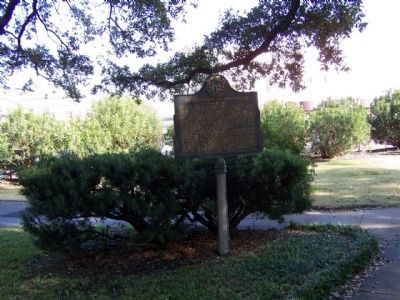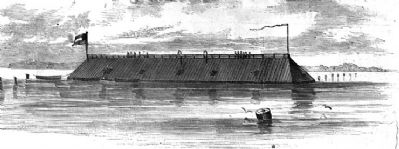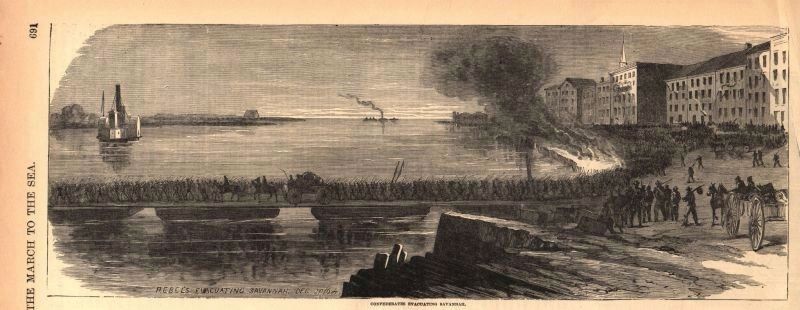Historic District - North in Savannah in Chatham County, Georgia — The American South (South Atlantic)
Evacuation of Savannah
On Dec. 14, 1864, Fort McAllister (CS) having fallen the day before, opening the Great Ogeechee River to Union shipping and rendering Savannah untenable, Lt. Gen. W. J. Hardee, CSA, decided to evacuate the city to save it from a destructive bombardment and to extricate his besieged army. River craft being unequal to the task and no pontoon bridging being available, an engineering expedient was adopted. Directed by Lt. Col. B. W. Frobel, CSA, pontoon type bridges were laid by sailors of the CS Navy and details from the Georgia Militia. Using large "cotton flats" for boats, car wheels for anchors and planks from the city wharves for flooring, a bridge was laid from the foot of West Broad Street to Hutchinson Island, another across Back River to Pennyworth Island, and a third across Little Back River to the South Carolina shore.
On the 19th, orders were issued giving priorities and times of withdrawal. The heavy guns were spiked and carriages and ammunition destroyed. At dark, the garrisons of Whitemarsh Island were withdrawn into the city and evacuated via the bridges.
At dark on the 20th, the garrisons of Causton's Bluff, Thunderbolt and the Savannah River batteries gathered at Fort Jackson and were transferred by steamer to Screven's Ferry; but the main garrison -- infantry, cavalry, light artillery and wagons -- crossed on the bridges. Well before dawn, the rear-guard had cleared Hutchinson Island, the bridge from West Broad Street had been cut adrift, and the troops were marching via the Union Causeway to Hardeeville.
Erected 1957 by Georgia Historical Commission. (Marker Number 025-52.)
Topics and series. This historical marker is listed in this topic list: War, US Civil. In addition, it is included in the Georgia Historical Society, and the Sherman’s March to the Sea series lists. A significant historical month for this entry is December 1937.
Location. 32° 4.905′ N, 81° 5.661′ W. Marker is in Savannah, Georgia, in Chatham County. It is in the Historic District - North. Marker is on West Bay Street near Jefferson Street, on the right when traveling west. Touch for map. Marker is in this post office area: Savannah GA 31401, United States of America. Touch for directions.
Other nearby markers. At least 8 other markers are within walking distance of this marker. The First Act of Alcohol Prohibition in America (about 400 feet away, measured in a direct line); Jonathan Bryan (about 400 feet away); Ships That Carried the Name Savannah (about 400 feet away); John Ryan's Excelsior Bottle Works (about 400 feet away); John Herndon “Johnny” Mercer (about 400 feet away); SS Savannah and SS John Randolph (about 500 feet away); William Bartram Trail (about 500 feet away); First African Baptist Church (about 500 feet away). Touch for a list and map of all markers in Savannah.
Regarding Evacuation of Savannah. In the Civil War, the Thunderbolt Battery was instrumental in the defense of Savannah. Thunderbolt never fell to the enemy, and increased armament and river obstructions kept the Union forces from landing. It was the advance of Union troops on Fort McAllister by land that led to the evacuation of Savannah and Thunderbolt Battery. Nothing remains of the Thunderbolt Battery today due to a combination of initial neglect and commercial and industrial development.
Also see . . .
1. The siege and evacuation of Savannah, Georgia, in December 1864. Internet Archive entry:
... an address delivered before the Confederate Survivors' Association, in Augusta, Georgia, on the occasion of its twelfth annual reunion on Memorial Day, April 26th, 1890 by Charles Colcock Jones (1831-1893) (Submitted on February 17, 2021, by Larry Gertner of New York, New York.)
2. CSS Georgia and Evacuation of Savannah. Wikipedia entry:
Since she lacked effective locomotive power, the Confederates found it necessary to burn and destroy her during the evacuation of Savannah on December 21, 1864. (Submitted on February 21, 2008, by Mike Stroud of Bluffton, South Carolina.)
3. Fort McAllister. New Georgia Encyclopedia entry (Submitted on February 17, 2021, by Larry Gertner of New York, New York.)
Credits. This page was last revised on February 8, 2023. It was originally submitted on February 21, 2008, by Mike Stroud of Bluffton, South Carolina. This page has been viewed 1,992 times since then and 61 times this year. Photos: 1. submitted on February 21, 2008, by Mike Stroud of Bluffton, South Carolina. 2, 3. submitted on December 19, 2008, by Mike Stroud of Bluffton, South Carolina. 4. submitted on February 21, 2008, by Mike Stroud of Bluffton, South Carolina. 5. submitted on February 17, 2021, by Larry Gertner of New York, New York. • Craig Swain was the editor who published this page.




